The digital world of the metaverse has come a long way from its conception in 1992 when sci-fi writer Neal Stephenson created it in his novel Snow Crash. In 2023, many are concerned with whether workplace adoption of metaverse technologies will become commonplace. While it may not become “the norm”, the WalkMe team has a suspicion it will gain popularity this year as we learn of more business-friendly applications for the technology. So much so that we named it one of the top ten strategic digital workplace trends for 2023.
Since the metaverse concept became popular, it has inflamed the imaginations of business leaders such as Mark Zuckerberg, who have poured billions of dollars in investments into tapping its profit-generating potential.
But what is the metaverse? What are the existing metaverse technologies, and why are they becoming popular in business? How can companies use metaverse technologies to improve operations and efficiency? Let’s begin with a definition.
What is the metaverse?
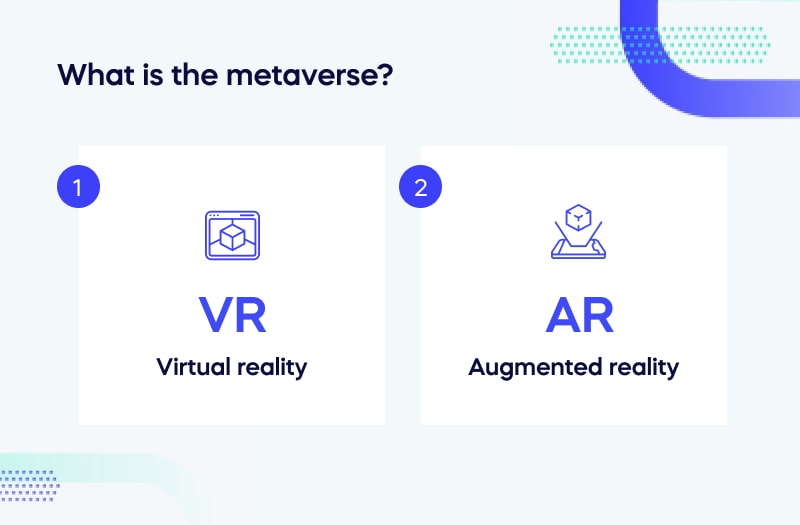
The metaverse space is a fascinating realm, bridging the gap between our physical and digital worlds. It presents many possibilities – all accessible with virtual reality (VR) headsets or augmented reality (AR) glasses. This digital landscape offers an immersive three-dimensional experience, unlike anything we’ve seen before, as we observe the metaverse concept merge different virtual worlds, each offering immersive experiences.
Not only can you explore this world, but you’re also free to create different environments and conduct financial transactions using digital assets or currencies. What’s more, the metaverse provides limitless opportunities for innovation; whatever your imagination can conjure up can be actualized in this new frontier of virtual experiences.
Now that we understand the nature of the Metaverse, we can take a closer look at Metaverse technology and why it is becoming popular in the world of business.
What are the existing metaverse technologies, and why are they becoming popular in business?
Over the past two years, metaverse trends and interest in this new technology have exploded. Let’s look at some examples of these technologies and why they have become so popular in business.
Virtual worlds and immersive technology
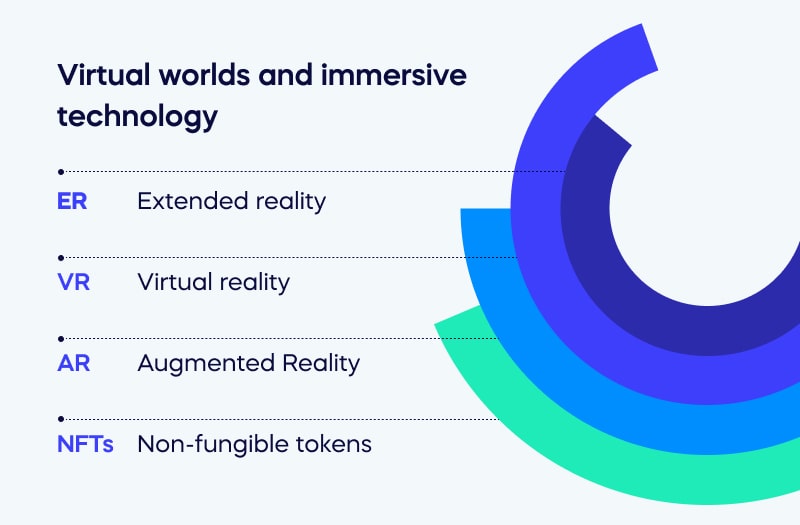
Digital worlds creating virtual reality and multiexperience environments form the core of the metaverse experience. ER (extended reality) is the starting point to begin understanding metaverse technological enablers.
ER
Extended reality is an umbrella term that covers all the below technologies, such as virtual and augmented reality. It is a popular term because companies can use it to describe all associated metaverse technologies without specifying individual items.
VR
Virtual reality headsets provide a new way of interacting with the virtual world. VR is key to unlocking the potential of the metaverse as users leave the physical world and all its limitations to enter and interact with experiential technology within the metaverse. Without VR, there could be no metaverse, and VR is the way many users will have first experienced this technology as they enter this virtual world.
AR
Augmented Reality (AR) is an innovative way to merge the physical world with digital elements such as visuals, sound, and more. With its ability to deliver through technology, AR has become a popular choice among businesses specializing in mobile computing and applications. Its potentials are limitless – the opportunities for business success are just waiting for companies to discover them.
NFTs
Non-fungible tokens (NFTs) are one-of-a-kind cryptographic assets on a blockchain, identified by unique codes and associated metadata. Unlike fungible cryptocurrencies, NFTs cannot be exchanged for each other or used as a medium for commercial transactions – an exclusive feature that makes them stand out.
Metaverse collaborative working environments
Working in the metaverse is a game-changer, allowing you to be productive no matter where you are. Create an immersive environment that caters to your needs and desires – you’ll experience improved productivity, creativity, and flexibility while saving money on expensive office spaces or equipment. With this innovative method of working, nothing stops you from achieving success.
In a post-coronavirus world, Metaverse workplaces are an invaluable resource. They enable teams to collaborate and communicate remotely from anywhere without ever having to come into contact with each other.
These are the technologies staff can use within the metaverse. But we need to look at how we can use these technologies to improve operations and boost efficiency.
How can businesses use metaverse technologies to improve their operations and efficiency?
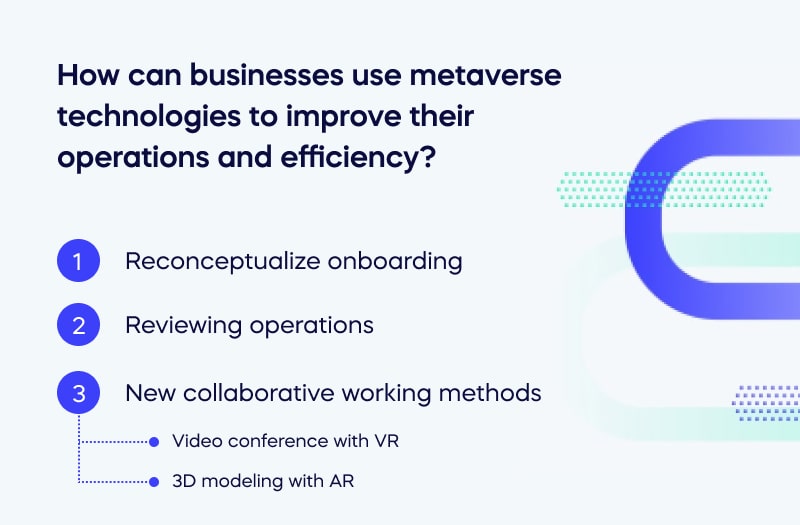
The metaverse has emerged as one of the most crucial tools for successful digital transformation in today’s tech industry, allowing businesses to improve their operations and boost efficiency in new and exciting ways from prime virtual locations. One highly anticipated application of metaverse technologies includes the function of employee onboarding.
Reconceptualize onboarding
Immersing new hires in a 3D virtual onboarding provides an unprecedented experience that companies can leverage to reconceptualize the employee experience. Recruits can tour the company’s headquarters, manufacturing facility, or any other space, allowing them better to grasp their organization’s culture and dynamics.
Consulting giant Accenture created a metaverse environment called Nth Floor. This environment is a prime example of enterprise metaverse capabilities. With both imaginative scenes and real-world environments, it serves as an interactive virtual campus for new hires to engage with their peers during orientation.
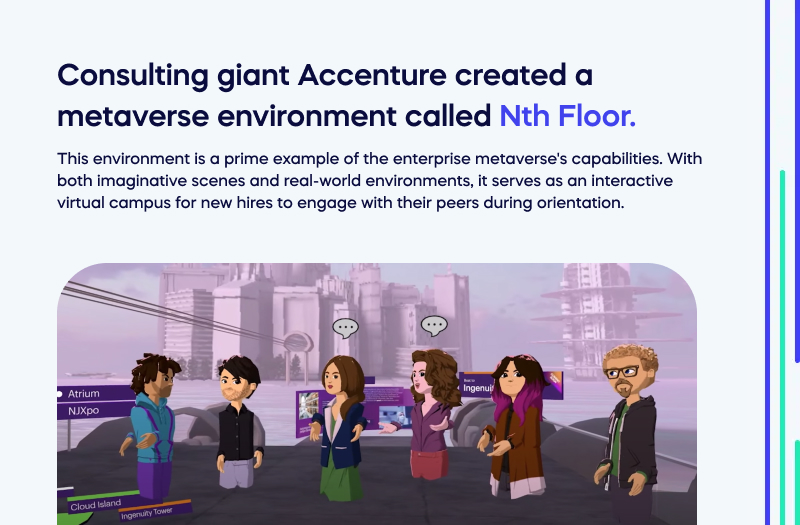
Reviewing operations
Through the metaverse, executives can conveniently experience a virtual tour of factories, distribution centers, and construction sites located in remote parts of their country or even on the other side of the globe. It allows them to evaluate current conditions, simulate potential changes, and partner with distant workers to work out solutions.
New collaborative working methods
One of the most significant advantages of AR is that companies can use it to support staff collaboration in ways never before possible. The two primary forms of cooperation using AR are video conference and 3D modeling, and each will have relevance to different industries.
However, it is essential not to rush into ordering hundreds of the latest AR headsets just yet, as both uses for AR also have limitations. It is vital to research what you need before authorizing procurement orders for this new immersive technology.
Video conference with VR
There are a range of VR tech trends emerging. For example, video conferencing became more widespread during the Covid-19 pandemic. As staff worked from home, technologies such as Zoom and Microsoft Teams became essential for businesses to run. Now, Meta creates virtual worlds using digital assets developed in Meta’s Reality Labs.
Spatial audio is another term used by Zuckerberg within Meta to make the experience of AR video conferencing feel more natural.
“[With spatial audio,] If someone’s talking from over there, it sounds like it’s talking from over there. You can see the arm gestures and stuff, which feels more natural.”
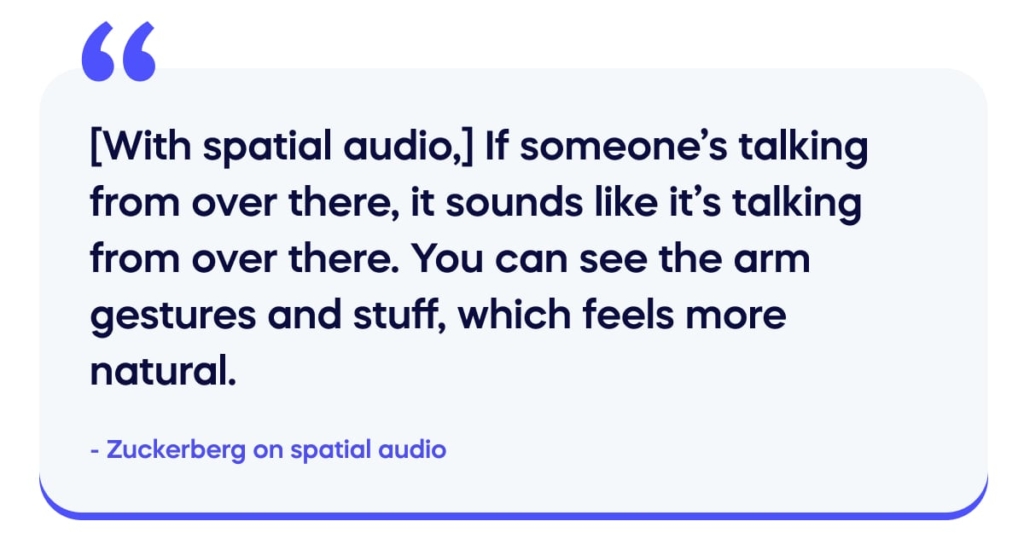
Zuckerberg on spatial audio
MS Teams may be adequate for many messaging needs, but AR video conferences can create a more engaging team communication experience for staff, promoting collaboration and cohesion. However, there are drawbacks that companies must consider before implementing AR, such as a tendency for some to experience motion sickness and not all staff feeling the need to meet on this personal level for every meeting.
3D modeling with AR
Nevertheless, virtual reality collaboration is more influential than a video conference when the issue requires tangible 3D elements like a product design or architectural plans.
Virtual reality allows us to do things that would be unimaginable in a Zoom environment. This innovative technology is changing how we work, play, and communicate across distances. Imagine the possibilities: two architects from different countries can collaborate and design a space together for a company in Singapore.
Now that we have established the metaverse’s operations and efficiency capabilities let’s look at how you can use it to improve your customer relationships.
How can your company use metaverse technologies to improve operations and communication with customers and clients?
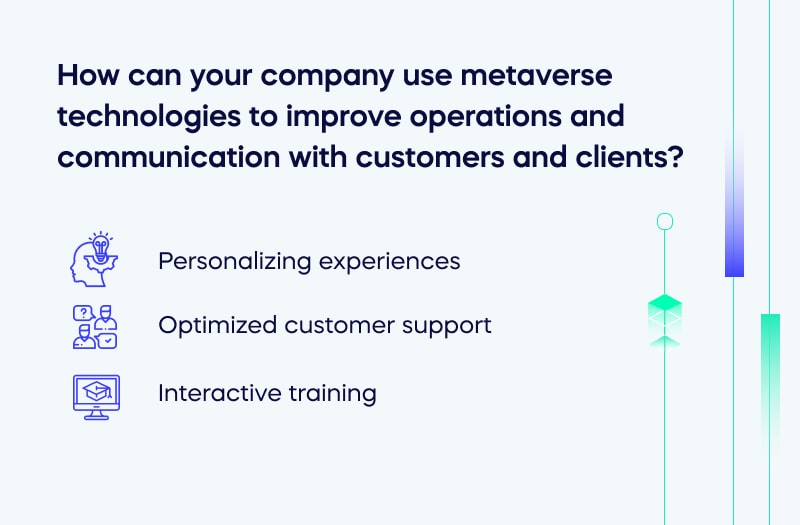
Before investing in this new technology, it’s important to consider how your company could use metaverse technologies to improve operations and communication with both employees and customers.
Personalizing experiences
Social media has opened up a world of possibilities for brands and businesses to personalize customer interactions and target marketing. With this unique approach, companies can personalize products to fit within a customer’s home. This point is critical since marketing company Epsilon shows that 80% of customers prefer brands that offer personalized experiences.
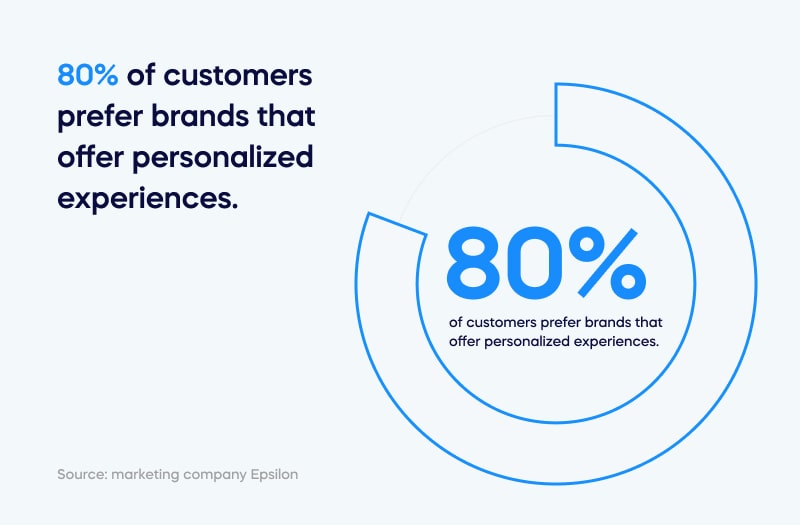
What could be more individualized than delivering 3D models directly into their living space? Leveraging the power of personalization in this way will increase your chances of boosting client and customer engagement to drive revenue growth.
Optimized customer support
Upgrade your company’s omnichannel support by including metaverse capabilities, enabling your customers to communicate through multiple channels. Channels can incorporate chatbox, email, or telephone calls.
Interactive training
Augmented learning environments enable organizations to efficiently train new hires from multiple locations and easily measure their success. Taking advantage of the metaverse has remarkable potential to increase quality. By using virtual reality, companies can benefit from providing life-like employee training experiences for customer service agents or sales teams in a previously impossible way.
Now let’s look at how businesses can tailor the metaverse to their specific needs.
How can businesses make the most of metaverse technologies for their specific needs?
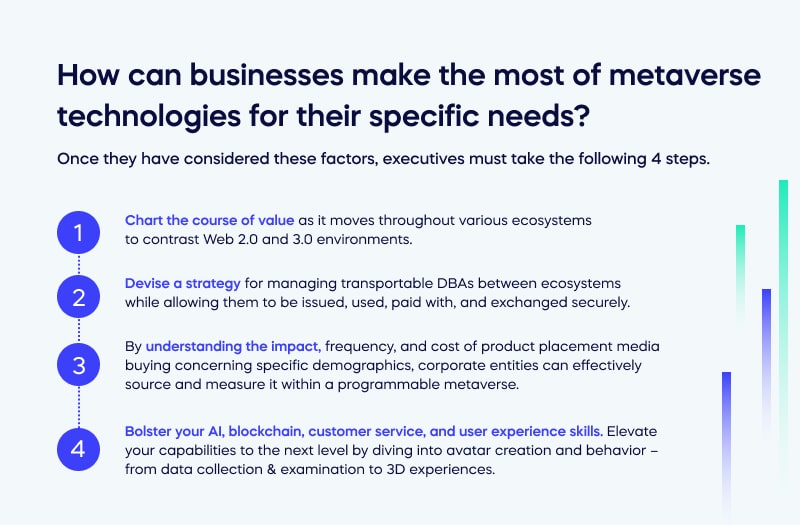
According to Gartner, the metaverse will offer economic benefits by utilizing novel digital business assets (DBAs) and monetary transaction models. To enhance your digital transformation approach, investigate how you can leverage product development, brand placements, customer interactions, and financial transactions within this virtual space.
Executives must consider many factors to make the most of metaverse technologies for their organization’s specific needs. This is especially crucial because the nature of the metaverse offers economic and customer engagement potential. Capturing its opportunities requires you to consider how:
- In programmable economies, markets have the opportunity to thrive.
- Businesses and financial organizations are using sophisticated models to maximize efficiency.
- DBAs are an integral part of customer engagement.
Customer demand drives Web 2.0 participants toward Web 3.0 capabilities using DBAs enabled by blockchain technologies.
Once they have considered these factors, executives must take the following four steps:
- Chart the course of value as it moves throughout various ecosystems to contrast Web 2.0 and 3.0 environments.
- Devise a strategy for managing transportable DBAs between ecosystems while allowing them to be issued, used, paid with, and exchanged securely.
- Understand the impact, frequency, and cost of product placement media buying concerning specific demographics in order to effectively source and measure it within a programmable metaverse.
- Bolster AI, blockchain and user experience skills. Utilize avatar creation and behavior – from data collection & examination to 3D experiences.
The above reasons are why tailoring the metaverse to your needs is essential. But integrating such radically new technology as the metaverse into digital workflows and processes is not without challenges, as we will now explore.
Challenges to integrating metaverse technologies into everyday workflows
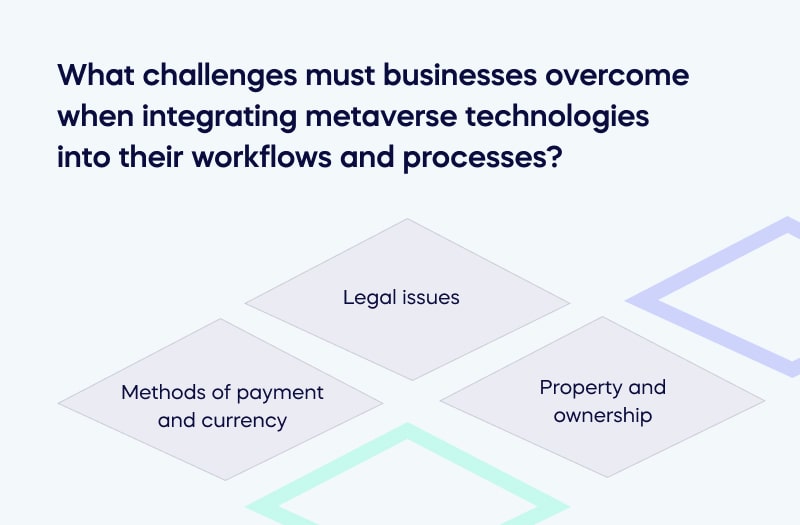
What challenges must businesses overcome when integrating metaverse technologies into their workflows and processes?
The metaverse trends may feel like they have existed for an extended period, but their use in a corporate and consumer environment is relatively new. While the metaverse promises to shift the paradigm of how we work, several challenges must first be addressed before integrating metaverse tech into workflows and processes. The first of these challenges look at methods of payment and currency.
Interoperability
Since the metaverse landscape is still in its infancy, organizations are yet to establish cross-platform standards. Cementing these standards, however, will allow users to:
- Collaborate virtually across multiple platforms.
- In the case of developers, access tools that they can use on different operating systems.
- Use authentication to allow employees to access metaverse environments securely.
As we glance towards the future, it is clear that many platforms of a large scale must tailor their business models to thrive within an interoperable metaverse.
Legal issues
As technology advances and we plunge into the metaverse, questions of virtual jurisdiction will arise. As more users across the globe gain access to this vast space, countries must discern how their governments can apply these laws fairly. We need to identify viable legal solutions that respect all international jurisdictions.
The metaverse offers a substantial potential for users to communicate and collaborate, but at the same time, its lack of laws may put those very users in vulnerable situations. Consequently, it is challenging to determine jurisdiction and create regulations that protect people from harm when using this virtual space. Finding ways to ensure safety and security within the metaverse must be an urgent priority as more companies join the metaverse platform.
Property and ownership
When we consider a single, unified virtual universe where one can connect with both the world and other individuals just as they do in real life, it’s not hard to imagine that there will be ways to acquire and possess all sorts of items and assets. 2022 saw a surge of interest in NFTs (Non-Fungible Tokens) from investors and users alike, bringing these digital assets and tokens into the limelight.
Just as they are presently used to provide proof of ownership for art, music, videos, and more in the real world, there is a need for a unified system that companies can leverage to authenticate possessors of virtual commodities within the Metaverse.
Are there any potential risks associated with using metaverse technologies in business settings?
Many potential risks are associated with using metaverse tech in business settings, starting with wearables.
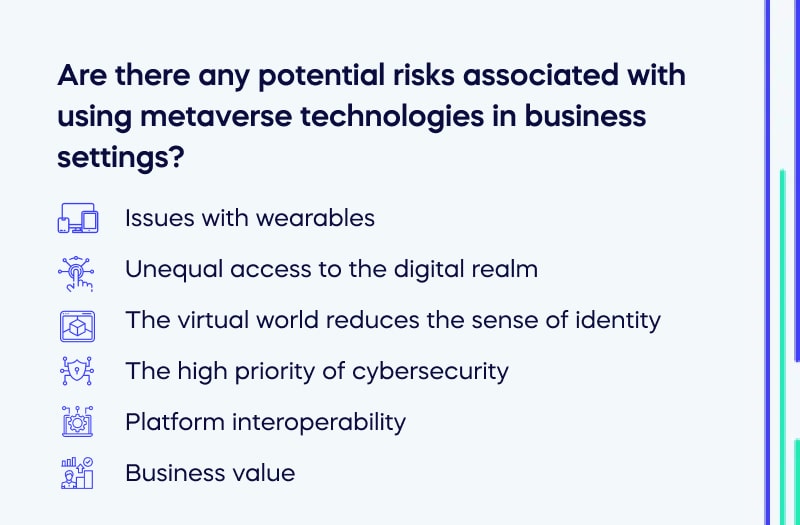
Issues with wearables
Companies must address the issues of using the hardware and software of the metaverse as they begin to navigate its 3D environments. The current virtual reality headsets are costly and uncomfortable, making it an unrewarding experience for users who plan on staying in such an environment long-term.
We must also consider price factors; the current cost puts them out of reach for many people. Therefore, if we want our technology to become widely accessible, it must be frictionless, user-friendly, and affordable enough so that everyone can enjoy its benefits.
The virtual world reduces the sense of identity
As the metaverse advances, we must anticipate and address its potential issues with security. Avatars in this virtual realm are susceptible to hacking, allowing criminals to take over identities for malicious purposes. Companies must launch security programs as soon as possible to protect virtual and real lives from VR-related crimes. In doing so, not only will we minimize risks but also enhance user experience.
The high priority of cybersecurity
The current conception of the metaverse requires tremendous amounts of personal and confidential information to be transferred and the potential for operators to sell user data. Therefore, cyber attacks will remain an ever-present danger as digital technology reliance increases. This situation increases the need to invest in security software to ensure data integrity during digital transformation.
Business value
For the metaverse to be successful, companies must create value from it. Thus, firms of all types should examine this new platform and at least utilize it as a different delivery and interactive channel in an integrated distribution structure. An example is how businesses use the web, social media platforms, or voice-controlled apps to engage with customers or convey their products.
Although we can have looked at the risks of the metaverse in its current form, it’s essential to consider what these digital environments will hold for the future.
How will the widespread adoption of emerging metaverse technologies impact businesses in the future?
There are many ways that the widespread adoption of emerging metaverse technologies will impact businesses in the future. The first involves Vollebak, a UK outdoor clothing company utilizing blockchain.
Clothing brand Vollebak has just taken a massive leap into blockchain technology by creating an innovative virtual store on Decentraland. Through this experience, users can purchase Vollebak’s signature digital jackets as Non-Fungible Tokens (NFTs), which are wearable throughout Decentraland. Moreover, customers can redeem virtual items for their physical version from Vollebak’s website.
Embrace the virtual reality environments of the metaverse today
The digital domain of the world wide web is spilling over into the metaverse environment, changing the online world forever.
Speed and accessibility to quality VR equipment are becoming less of a deterrent to entry for many users. Companies can create fun, social experiences or use the metaverse for business marketing purposes–endless possibilities. The time to invest in the metaverse is now.


